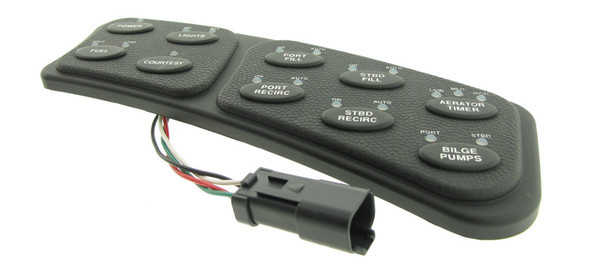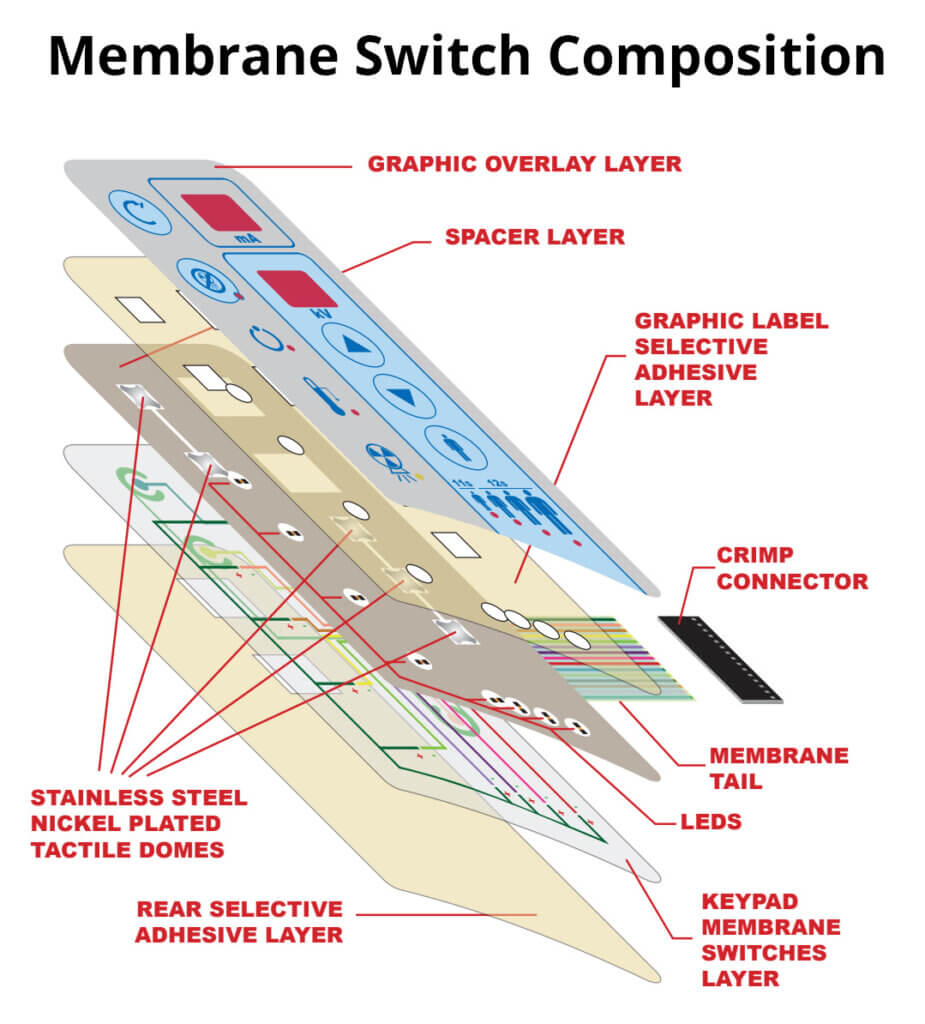How membrane switch is improving user interaction in medical devices
Wiki Article
All Concerning Membrane layer Switch Over: A Comprehensive Overview for Beginners
Membrane layer switches are important elements in modern-day electronics, offering a special interface for individual interaction - membrane switch. Their layered building, including overlays and conductive traces, supplies capability and durability. Unlike traditional mechanical switches, membrane buttons present a smooth style and customizable choices. Comprehending their essential attributes and benefits can change item layout. The intricacies of their application and design factors to consider require more exploration.What Is a Membrane layer Switch over?
A membrane switch is a kind of electrical switch that is composed of a versatile membrane layered over a published circuit board. This design permits a small and smooth user interface, typically made use of in various electronic gadgets. Membrane layer buttons are commonly found in consumer devices, clinical equipment, and industrial machinery because of their longevity and resistance to environmental factors.The building generally includes several layers, such as visuals overlays and glue backing, which offer responsive responses and shield the wiring below. The operation of a membrane switch is started when stress is put on the surface, completing an electrical circuit.These switches are valued for their flexibility, making it possible for personalized styles and printed graphics that cater to details customer interfaces. Their inconspicuous nature decreases space demands, making them suitable for applications where traditional switches might not fit. On the whole, membrane layer buttons use a aesthetic and functional solution for modern-day digital gadgets.Key Elements of Membrane Switches
Membrane layer changes comprise numerous vital elements that add to their functionality and efficiency. The top layer, referred to as the overlay, provides the customer interface and is often published with signs or graphics. Beneath the overlay exists a spacer layer, which separates the conductive elements and protects against unintended activation. The next crucial element is the visuals layer, which improves appearances and assures the resilience of the design.Conductive traces, generally made from products like silver or carbon, are printed on the circuit layer. When stress is related to the overlay, these traces come right into contact, completing the circuit. Additionally, a support layer supplies structural assistance and can be made from products such as polyester or polycarbonate. Together, these parts produce a reliable, straightforward user interface ideal for different applications, from household devices to industrial devices. Recognizing these elements is important for anybody interested in membrane layer switch modern technology.How Membrane Layer Switches Work
Recognizing how membrane changes feature is essential for valuing their widespread usage in various gadgets. A membrane layer button operates through a series of layers, consisting of a visuals overlay, spacer, and a circuit layer. When pressure is related to the overlay, it compresses the spacer layer, allowing the circuit layer to make call and complete an electrical circuit. This action sends a signal to the gadget, motivating a response, such as switching on a light or triggering a function.Membrane changes can be developed with different attributes, consisting of responsive feedback, backlighting, and custom graphics, boosting customer communication. Their construction enables a closed style, shielding the interior parts from dirt, moisture, and contaminants. This longevity makes them ideal for varied applications, from customer electronic devices to commercial tools. Overall, the simplicity and effectiveness of membrane switches over add to their appeal in modern-day technology.Advantages of Membrane Switches Over Mechanical Buttons
While mechanical buttons have long been a staple in several tools, membrane switches over offer distinct advantages that make them progressively appealing. One considerable benefit is their slim account, permitting even more small styles and greater flexibility in item growth. Furthermore, membrane switches attribute a consistent surface, which enhances visual allure and simplifies cleaning, making them suitable for settings where hygiene is critical.Another advantage is their resistance to dirt and moisture. Unlike mechanical buttons, which can be jeopardized by ecological factors, membrane layer switches provide a sealed interface that secures against contaminants - membrane switch. Membrane buttons usually have a longer lifespan due to less moving components, resulting in enhanced longevity and reliability.Cost-effectiveness is likewise a notable advantage, as membrane layer switches can be generated in mass with lower manufacturing prices. These variables integrate to position membrane layer switches as a practical option to traditional mechanical alternatives in various applicationsTypical Applications of Membrane Layer Changes
Membrane layer buttons are widely utilized in numerous sectors, especially in customer electronic devices and commercial control panels. In consumer gadgets, they provide a smooth, straightforward user interface, while in industrial settings, they boost toughness and capability. Understanding these applications highlights the Full Report adaptability and usefulness of membrane layer buttons in modern technology.Customer Electronic Devices Devices
As consumer electronics remain to progress, membrane layer buttons have actually ended up being a preferred selection for a selection of tools as a result of their adaptability and smooth layout. These switches are commonly located in smartphones, tablets, and remote controls, where area is limited and appearances matter. Their reduced profile and adjustable layouts permit suppliers to develop straightforward user interfaces that boost the total individual experience. Furthermore, membrane switches are frequently used in appliances such as microwaves and coffee makers, giving instinctive control alternatives while resisting dampness and dust. The longevity and integrity of membrane switches make them suitable for day-to-day consumer products, making certain long life and constant performance. On the whole, their combination in consumer electronic devices mirrors a blend of capability and modern-day style.Industrial Control Panels
The applications of membrane switches over prolong beyond customer electronics, locating substantial use in commercial control board. These switches are preferred for their resilience and resistance to harsh settings, making them optimal for manufacturing and procedure control settings. They supply a reputable interface for operators to regulate equipment, display procedures, and change setups. Membrane layer buttons can be customized to match particular functional needs, including functions like backlighting and responsive feedback, improving user experience. Their low-profile layout enables for assimilation into different tools, while their ability to hold up against spills, dust, and severe temperature levels guarantees long life. In general, membrane layer buttons contribute to effective and secure procedure in industrial applications, demonstrating their convenience and effectiveness popular settings.Factors To Consider for Designing Membrane Changes
When making membrane switches, selecting the best products is important to guarantee sturdiness and capability. In addition, understanding layer configuration methods can considerably influence the button's efficiency and customer experience. These factors to consider play an important role in creating trustworthy and efficient membrane layer button styles.
Product Option Relevance
Material selection plays a crucial function in the style and performance of membrane switches. The chosen products straight impact the button's durability, responsive feedback, and total visual. Secret considerations include the substratum, which have to give architectural stability while permitting flexibility, and the visuals overlay, which requires to be resistant to wear and ecological aspects. Conductive materials should assure trusted electric performance, while adhesives must supply solid bonding without compromising the button's procedure. Additionally, compatibility with producing processes and end-user atmospheres is vital; products need to endure varying temperature levels, humidity degrees, and chemical exposure. Ultimately, proper product choice not only boosts the membrane button's efficiency however likewise adds to its long life and individual fulfillment, making it a critical facet of the design procedure.
Layer Arrangement Strategies

Frequently Asked Concerns
For How Long Do Membrane Layer Changes Commonly Last?
Membrane buttons generally have a life expectancy of 1 to 5 million cycles, depending on usage and ecological problems. Elements such as layout quality and operating frequency substantially influence their toughness and overall performance long life.
Can Membrane Layer Changes Be Personalized for Specific Designs?
Membrane buttons can without a doubt be personalized to suit specific layouts, enabling varied shapes, shades, and functionalities. This adaptability allows makers to tailor these switches to fulfill distinct visual and functional requirements effectively.What Materials Are Made Use Of in Membrane Switch Over Building And Construction?
Membrane layer switches are commonly built making use of materials such as polyester, polycarbonate, and glue layers. These materials supply flexibility, longevity, and resistance to ecological variables, guaranteeing the buttons operate effectively in different applications and problems.
Are Membrane Layer Switches Waterproof or Resistant to Dampness?
Membrane switches can be developed to be moisture-resistant, using specialized layers and materials. Their water resistant abilities depend on building high quality and particular applications, making it necessary to examine demands for suitable efficiency in different atmospheres.How Are Membrane Changes Repaired if Harmed?
Fixing broken membrane changes usually involves changing the impacted layer or circuit. Technicians might likewise apply conductive glue or utilize specialized repair kits, making certain capability is brought back without total replacement of the whole button assembly. Unlike traditional mechanical buttons, membrane switches offer a smooth design and personalized choices. A membrane button is a type of electrical button that consists of a flexible membrane layer layered over a printed circuit board. The procedure of a membrane button is started when pressure is used to the surface, finishing an electrical circuit.These switches are valued for their convenience, allowing custom styles and published graphics that cater to specific individual interfaces. While mechanical switches have actually long been a staple in numerous tools, membrane switches over offer unique advantages that make them significantly appealing. Membrane buttons usually have a longer life-span due to fewer relocating parts, resulting in improved resilience and reliability.Cost-effectiveness is additionally a noteworthy advantage, as membrane switches can be generated in bulk with lower production prices.Report this wiki page